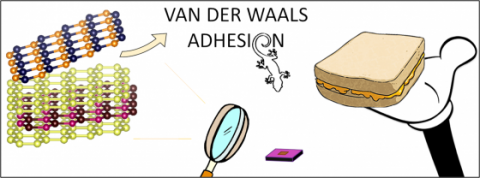Tasting adhesion energies in atomically thin sandwiches

Van der Waals forces rule a variety of macroscopic phenomena ranging from the scotch tape action to the way geckos stick to walls. Likewise, these forces are ubiquitous in the microscopic world. A method to probe these yet unknown forces in atomically thin crystals was recently developed by Elena Blundo and Prof. Antonio Polimeni, in collaboration with researchers at the National Institute for Materials Science in Japan (Dr. Tanju Yildirim) and at the Institute for Photonics and Nanotechnologies of the CNR (Dr. Giorgio Pettinari).
In marmalade sandwiches, the different bread slices can slide or detach, thanks to the relatively weak marmalade-mediated adhesion between them. Analogously, in atomic-scale sandwiches represented by layered crystals, the different layers are kept together by the weak van der Waals adhesion. In turn, single atomically thin slices can be separated —such as graphene from graphite— or stacked together to form tasty multi-layer sandwiches. The adhesion energy is thus a fundamental parameter of critical importance, although methods to quantify it were lacking. Indeed, a new class of optical and electronic devices is developing based on multi-layered two-dimensional crystals and the way single layers interact will influence the device properties and performances
In a paper recently published in Physical Review Letters, E. Blundo et al. created microscopic architectures in layered crystals, at the interface between different layers, in the shape of gas-pressurized bubbles. The shape and deformation field of these microscopic bubbles were characterised by scanning probe microscopy experiments and Raman scattering measurements. The precise knowledge of the shape and deformation allowed the authors to develop an analytical model to describe these micro-scale curved architectures, highlighting how the bubble equilibrium condition is established by the competition between the gas expansion, the elastic properties of the atomically thin sheet, and the adhesion with the substrate. In turn, by characterising the equilibrium shape and deformation field of these microscopic bubbles, E. Blundo et al. unprecedentedly estimated the adhesion energy for a variety of layered crystal combinations.
The approach presented in this work provides a valid tool to assess the easiness of exfoliation of a van der Waals crystal and the quality of two-dimensional heterostructures. It also represents an important benchmark for testing the validity of molecular dynamics and density functional theory applied to these systems.
Finally, the precise analytical knowledge of the bubble shape and strain field opens new routes to interpret the strain-induced changes in the electronic properties of the material and to quantify pseudogauge and piezoelectric fields.
Authors:
Elena Blundo, Prof. Antonio Polimeni
Reference:
Physical Review Letters
